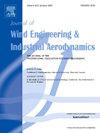大尺度湍流产生风洞风机特性研究
IF 4.9
2区 工程技术
Q1 ENGINEERING, CIVIL
Journal of Wind Engineering and Industrial Aerodynamics
Pub Date : 2025-10-01
DOI:10.1016/j.jweia.2025.106219
引用次数: 0
摘要
风洞试验要求准确地复制自然流动特性。在风力工程和风能研究中,需要生成真实的风况来捕捉系统动力学。特别是,大型涡状结构可以在桥梁和高层建筑上产生相关力,可能导致危险的不稳定。传统的被动湍流生成方法,如网格和尖顶单元,在湍流的尺度和强度上受到限制。像移动电网这样的主动技术虽然更有效,但却难以产生低频元件,而且往往需要高昂的安装成本。一个很有前途的、经济的替代方案是主动控制设施的风扇,它可以将能量注入湍流频谱的低频范围,从而可以研究瞬态现象,再现非天气风和其他具有定制特征的气流。本研究提出了一种直观的方法来描述风洞风扇作为湍流发生器的特征,并提供了对其潜力和局限性的见解。本文章由计算机程序翻译,如有差异,请以英文原文为准。
Characterizing wind tunnel fans for large-scale turbulence generation
Wind tunnel testing requires the accurate replication of natural flow characteristics. In wind engineering and wind energy research the generation of realistic wind conditions is needed to capture the system dynamics. In particular, large vorticose structures can induce correlated forces on bridges and high-rise buildings, potentially leading to dangerous instabilities. Traditional passive turbulence generation methods, such as grids and spire elements, are limited in turbulence scales and intensity. Active techniques like moving grids, while more effective, struggle to generate low-frequency components and often come with high installation costs. A promising, cost-effective alternative is the active control of the facility’s fans, which can inject energy into the low-frequency range of the turbulence spectrum, allowing the study of transient phenomena, reproducing non-synoptic winds and other flows with custom characteristics. This study presents a straightforward methodology for characterizing wind tunnel fans as turbulence generators, offering insights into their potential and limitations.
求助全文
通过发布文献求助,成功后即可免费获取论文全文。
去求助
来源期刊
CiteScore
8.90
自引率
22.90%
发文量
306
审稿时长
4.4 months
期刊介绍:
The objective of the journal is to provide a means for the publication and interchange of information, on an international basis, on all those aspects of wind engineering that are included in the activities of the International Association for Wind Engineering http://www.iawe.org/. These are: social and economic impact of wind effects; wind characteristics and structure, local wind environments, wind loads and structural response, diffusion, pollutant dispersion and matter transport, wind effects on building heat loss and ventilation, wind effects on transport systems, aerodynamic aspects of wind energy generation, and codification of wind effects.
Papers on these subjects describing full-scale measurements, wind-tunnel simulation studies, computational or theoretical methods are published, as well as papers dealing with the development of techniques and apparatus for wind engineering experiments.

 求助内容:
求助内容: 应助结果提醒方式:
应助结果提醒方式:


